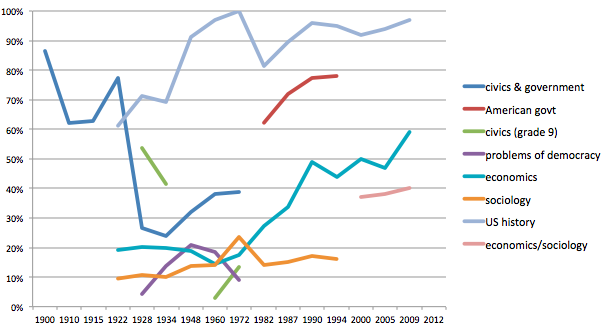For several years, Joe Kahne and his colleagues have been conducting intensive research on young people’s use of digital media for politics and what that means for education. Their research has taken the form of large-scale youth surveys, interviews, and experiments. The following is a broad and detailed new article that pulls together much of their research and provides concrete examples of classroom practice:
Joseph Kahne, Erica Hodgin & Elyse Eidman-Aadahl, “Redesigning Civic Education for the Digital Age: Participatory Politics and the Pursuit of Democratic Engagement,” Theory & Research in Social Education, Volume 44, Issue 1, 2016, pp. 1-35 (open access)
The authors address two concerns that I have raised in previous work. First, “Many efforts to produce and circulate content will confront what Levine has termed ‘the audience problem’ (2008, p. 129). Simply put, many blogs or other digital content may get relatively few views and little or no response.” I would add that this is almost a logical inevitability because there aren’t enough eyeballs to allow millions of content-producers all to reach large audiences. As I can testify from years of experience, the median blog or video reaches just a few. The authors reply:
Of course, many off-line political activities also fail to engage many members of the public. We would classify a blog that addresses a political issue but has few readers an act of participatory politics just as we would classify a protest that people ignore as a political activity. That said, clearly, the power of public voice is diminished if one fails to reach a public. This reality highlights the need for educators to help set realistic expectations and to support and scaffold activities so that youth can more effectively produce and circulate political content.
Second, “a number of scholars (Levine, in press; Sifry, 2014) have detailed ways that individuals’ and non-institutionalized groups’ efforts to achieve greater voice by leveraging the power of the digital media often fail to prompt institutional change. Expressing caution, Milner (2010) wrote, ‘[youth who] turn their backs on [institutional] politics in favor of individual expression will continue to find their priorities at the top of society’s wish list–and at the bottom of the ‘to do’ list”(p. 5).” Here I would add that loose online movements are frequently defeated by disciplined organizations, such as corporations, armies, and security agencies. But the authors reply:
one might note that a wide range of significant change efforts ranging from #BlackLivesMatter, to the DREAMer movement, to the protests against SOPA, to the push for marriage equality have employed digital media in ways that changed public attitudes and that these changes have enabled new legislation. Still, the concern remains. Watkins (2014) noted, for example, that when it comes to digital media, youth are often “power users” (frequent users), but they are not necessarily “powerful users” (influential users). In order for youth to realize the full potential of participatory politics, they will frequently need to both understand and connect their efforts to institutional politics. Helping youth identify ways to build bridges from voice to influence is vitally important.
These are just two of many issues discussed in this extensive and deeply researched survey article.

